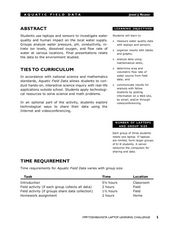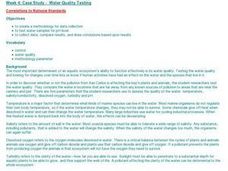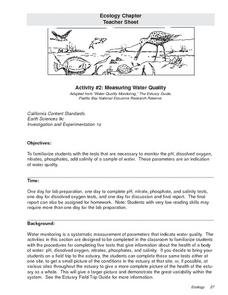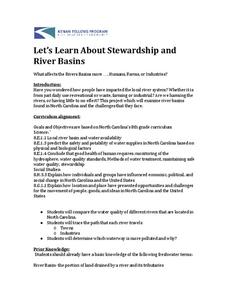Curated OER
Water Anaysis
Young scholars conduct three tests of water quality that can be utilized with TerrAqua columns and outdoors: pH, dissolved oxygen, and temperature. They make comparisons between different types of water and draw conclusions about how...
Curated OER
Aquatic Field Data
Students use laptops and sensors to measure water quality and graph their results. In this aquatics instructional activity students post their results to a website or email.
Kenan Fellows
Sustainability: Learning for a Lifetime – The Importance of Water
Water is essential for life—and understanding the importance of clean drinking water is essential in understanding sustainability! Show your environmental science class the basics of water testing and treatment through a week-long...
Curated OER
To Drink or not to Drink
Seventh graders discuss water quality, water availability and water resources and how water is used in the world around them. They view a video on water quality then test for pH, temperature and dissolved oxygen to indicate water quality.
Curated OER
Water Quality Testing
Student explore factors affecting ecosystems. They test local water samples for pH level. After creating a methodology for data collection, they collect data, compare results, and draw conclusions based upon results.
Curated OER
Healthy Water!?
Students test water for its quality and record their information.In this water quality lesson, students investigate water for pH, macro invertebrates and identify its characteristics. Students complete worksheets on their data for their...
Curated OER
Take a Dip: The Water in our Lives
Students collect water samples from local freshwater sources and test for pH, dissolved oxygen, nitrates, macroinvertebrates, phosphates, and coliform bacteria in order to determine water quality for each source.
Curated OER
Stream Chemistry Monitoring
Students become familiar with real-world gathering of chemical data. The experience how the science is done: the nature of analysis, data collection, interpretation, and presentation. They study a nearby body of water for their experiment.
Curated OER
Acids and Bases
In this acids and bases worksheet, students review the characteristics of acids and bases, pK values, factors that change the rate of reactions, and catalysts. This worksheet has 17 multiple choice questions.
Curated OER
Why Is Our Stream Changing?
Learners test turbidity, pH, oxygen content and temperature of local stream. In this earth science instructional activity, students collect and record data from the experiment. They analyze findings and present it to class.
Michigan Sea Grant
Water Quality
Learners observe water samples and measure the samples' water quality. Students develop their own criteria for measuring water quality and test for temperature, acidity, oxygen levels, turbidity, conductance, sediment and hardness.
Curated OER
What Is In The Water?
Students investigate the biotic and abiotic factors that are found in an aquatic ecosystem. The emphasis is upon the investigation of present an projections of future water quality. Then students visit a local body of water to gather...
Curated OER
Acids and Bases
In this acids and bases worksheet, students complete 32 fill in the blank and short answer questions on acidity or alkalinity. They color molecular diagram according to the key.
Curated OER
Field Trip to test Water Quality
Students examine water quality indicators,test water quality and record their results. In this water quality lesson students complete a water testing lab and complete a lab report.
Curated OER
Water Quality Tests Explained
Students identify the eight tests done to check for water quality. In this ecology lesson, students explain why it's important to test water in rivers. They explore sources of river water pollution.
Curated OER
Measuring Water Quality
Students are introduced to the various methods of measuring water quality. In groups, they test various water samples using the different methods, writing them down for pH, oxygen, salinity, and nitrate levels. They use their data to...
Curated OER
Water Quality Survey: Monitoring the Sustainability of Pigeon Creek
High schoolers research the History of Pigeon Creek (or any watershed in your area). In this environmental science lesson, students conduct field tests such as pH and nitrates. They collect data and compare what they collected with other...
Kenan Fellows
Let's Learn About Stewardship and River Basins
What does it mean to be a good steward? Middle school environmentalists learn to care for their state's waterways through research, a guest speaker, and poster activity. Groups must locate and learn more about a river basin and the human...
Kenan Fellows
Making Connections with Water Quality
What's in your water? And, why is water quality so important? Enhance your class's level of water appreciation through a lesson that demonstrates the necessity of water quality. Environmental enthusiasts explore the EPA's Clean Water...
Curated OER
Nature and Fitness Trail
Students plan stations for a nature and fitness trail and construct an accompanying e-Book for extended descriptions at each station. Data on the human impact on the environment is gathered in this activity.
Curated OER
Leaf - It's What's for Dinner
Learners discover correlations in food preferences of invertebrates, and assess stream health through use of kicknets, invertebrate keys, CBL systems and probes.
Curated OER
Embryological Development Using Medaka Fish
Students analyze and record major events that occur in the development of Medaka fish eggs from fertilization to hatching. In small group, students describe the processes involved, creating a timeline of the major events in the...
Curated OER
Thermal Stratification
Young scholars use video, research and experiments to investigate and replicate thermal stratification in a lab. They prepare a report, poster or multimedia presentation showing the results of their work.
Curated OER
What's in the Water?
Fifth graders use the dots to simulate water pollutants in a lake. They use cups to collect a sample of "water." Students sort the dots by color and record the number of each dot color under the correct pollutant name in the Lake Water...

























